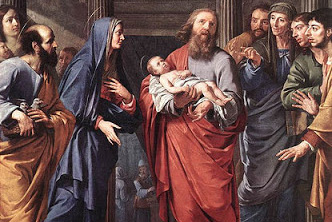 The moment of the Presentation of Jesus was one of the most dramatic in biblical history, yet almost no one noticed.
The moment of the Presentation of Jesus was one of the most dramatic in biblical history, yet almost no one noticed.
The first part of this post is review for those of you who read my blog regularly. To skip to the newer insights, skip down to the sentence in red.
Joseph and Mary have gone to Jerusalem to fulfill two ancient mandates: the Rite of Purification for a woman after childbirth and the Rite of Presentation for a firstborn male child. These rites set the stage for a dramatic moment in biblical history, a moment missed by almost everyone.
Jewish law considered that after a woman gave birth she was ritually impure for a period of time. This was based on the flow of blood that occurred during childbirth. At that time, just about anyone who came in contact with blood incurred a ritual uncleanness for a period of time. The Book of Leviticus has this to say regarding a woman who has given birth:
The LORD said to Moses, “Say to the Israelites: A woman who becomes pregnant and gives birth to a son will be ceremonially unclean for seven days, just as she is unclean during her monthly period. On the eighth day the boy is to be circumcised. Then the woman must wait thirty-three days to be purified from her bleeding. She must not touch anything sacred or go to the sanctuary until the days of her purification are over. If she gives birth to a daughter, for two weeks the woman will be unclean, as during her period. Then she must wait sixty-six days to be purified from her bleeding. When the days of her purification for a son or daughter are over, she is to bring to the priest at the entrance to the Tent of Meeting a year-old lamb for a burnt offering and a young pigeon or a dove for a sin offering. He shall offer them before the LORD to make atonement for her, and then she will be ceremonially clean from her flow of blood.” ‘These are the regulations for the woman who gives birth to a boy or a girl. If she cannot afford a lamb, she is to bring two doves or two young pigeons, one for a burnt offering and the other for a sin offering. In this way the priest will make atonement for her, and she will be clean” (Lev 12:1-8).
Some see a fairly negative concept at work here: a woman becomes ritually unclean by giving birth. This was due not to giving birth per se but to the flow of blood and other fluids during the process. Even more distressing to modern sensibilities is that a woman who gave birth to a daughter was considered ritually unclean for an even longer period of time. Alas, it is well that the power of the Church to bind and loose has freed us from this thinking. Keep in mind that this was ceremonial law, not moral law; hence, the Church is not setting aside immutable moral law in abrogating such notions of ritual impurity.
Obedient to the Law – Nevertheless Joseph and Mary, obedient to law, make the dramatic ascent to the Temple with the Son of God carried in Mary’s arms. It has been forty days since the birth of the Lord in fulfillment of the Law.
As they ascend the glorious steps to the Temple Mount they also fulfill another requirement of the Law:
You are to give over to the LORD the first offspring of every womb. All the firstborn males of your livestock belong to the LORD. Redeem with a lamb every firstborn donkey, but if you do not redeem it, break its neck. Redeem every firstborn among your sons. In days to come, when your son asks you, ‘What does this mean?’ say to him, ‘With a mighty hand the LORD brought us out of Egypt, out of the land of slavery. When Pharaoh stubbornly refused to let us go, the LORD killed the firstborn of both people and animals in Egypt. This is why I sacrifice to the LORD the first male offspring of every womb and redeem each of my firstborn sons’’ (Ex 13:12-15).
Something even more dramatic takes place here. To understand what it is, let’s look back to 587 B.C.
The Babylonians had invaded Jerusalem and the unthinkable had happened. The Holy City was destroyed and, along with it, the Temple of God. Inside the Temple something even more precious than the building had been housed: the Ark of the Covenant.
Recall what the Ark of Covenant was in the Old Testament. It was a box of acacia wood, covered in gold. Inside it were placed the two tablets on which God had inscribed the Ten Commandments. Also in it was the staff of Aaron and a vial of the manna. Even more important, in this box, this ark, dwelt the very Presence of God in Israel. God mysteriously dwelt within, much as is the case today in our understanding of the tabernacle in our Catholic churches.
The Lost Ark – Incredibly, however, the Ark was lost when the Babylonians destroyed the Temple and Jerusalem in 587 BC. Some thought that Jeremiah had hidden it in the mountains. Others, that the priests had hastily hidden it in the maze of caves beneath the Temple Mount. Still others argued that it was taken to Ethiopia. But the Ark was gone.
Empty Temple – When the Temple was rebuilt some eighty years later, the Holy of Holies was restored but the Ark was still missing. The High Priest still performed the yearly ritual and entered the Holy of Holies, but the room was empty. Some argued for a spiritual presence in the Temple, but in fact the Ark and the certain presence of God were missing in the Temple after 587 B.C. Something—someone—was missing. The very Holy of Holies was an empty room. The Ark and the presence of God it carried were missing. The Ark, the mercy seat, was gone. Would it ever be found? Would it ever be returned to the Temple? Would the Holy Presence of God ever find its way to the Temple again?
The ascent to Jerusalem is a steep one. Mountains surround Jerusalem and it sits up at a higher altitude than the area around it. As the ancient Jews made the climb they sang the psalms of ascent (120-134). As Joseph and Mary ascended, they too sang the words that instilled joy: I Lift up mine eye to the mountains from whence cometh my help (Ps 121). I rejoiced when they said to me let us go up to the House of the Lord (Ps 122). To you O Lord I have lifted my eyes (Ps 123). Like Mount Zion are those who trust in the Lord (Ps 125). Out of the depths I call unto you O Lord (Ps 130). Let us enter God’s dwelling, let us worship at the Lord’s footstool. Arise O Lord and enter your dwelling place, You and the Ark of your strength (132). Come and bless the Lord. You who stand in the House of the Lord Lift your hands to the Sanctuary and bless the Lord. The Lord bless you from Zion (134).
Singing these songs, Mary carried Jesus. The climb was even more difficult when carrying a newborn, but the burden was sweet. Then came the final ascent up the stairs to the Temple Mount. They probably entered on the southern side through the Huldah gates. They went up the steep stairs, through the tunnel in the walls, and emerged on the bright Temple platform above.
God had returned to His Temple. He and the Ark who carried Him were now found. Mary, the Ark, carrying Jesus in her arms. Jesus, very God, true God from True God. Yes, God and the Ark had been found and God was once again present among His people on the Temple Mount. Scripture says,
And the Lord, whom ye seek, shall suddenly come to his Temple, even the messenger of the covenant, whom ye delight in: behold, he shall come, saith the LORD of hosts. But who may abide the day of his coming? and who shall stand when he appeareth? (Mal 3:1-2)
What a dramatic moment and yet what a remarkable understatement by God! If I had directed the moment I would have called for blaring trumpet, claps of thunder, and multitudes of angels! And everyone would have fallen to his knees in recognition of the great fulfillment and the great return of God to His Temple.
Yet it would seem that only an elderly man and woman (Simeon and Anna) took any note at all. They alone understood that they were in the presence of greatness and beheld the drama of the moment.
Now there was a man in Jerusalem called Simeon, who was righteous and devout. He was waiting for the consolation of Israel, and the Holy Spirit was upon him. It had been revealed to him by the Holy Spirit that he would not die before he had seen the Lord’s Christ. Moved by the Spirit, he went into the temple courts. When the parents brought in the child Jesus to do for him what the custom of the Law required, Simeon took him in his arms and praised God, saying: “Sovereign Lord, as you have promised, you now dismiss your servant in peace. For my eyes have seen your salvation, which you have prepared in the sight of all people, a light for revelation to the Gentiles and for glory to your people Israel.” The child’s father and mother marveled at what was said about him. Then Simeon blessed them and said to Mary, his mother: “This child is destined to cause the falling and rising of many in Israel, and to be a sign that will be spoken against, so that the thoughts of many hearts will be revealed. And a sword will pierce your own soul too.” There was also a prophetess, Anna … Coming up to them at that very moment, she gave thanks to God and spoke about the child to all who were looking forward to the redemption of Jerusalem (Luke 2).
Yes, this was the dramatic moment that had been anticipated for centuries. The Ark of God was found (Mary) and God (Jesus) returned to His temple, but only a few noticed. Just a few understood and celebrated.
What about us? At every Mass, Jesus, God Himself, is present. Do you notice? Do you really see Him? Or do you see only the priest and the human elements of the Mass? Are you Simeon? Anna? Mary? Joseph? Or are you just among those on the Temple Mount who miss the dramatic moment of God with us?

